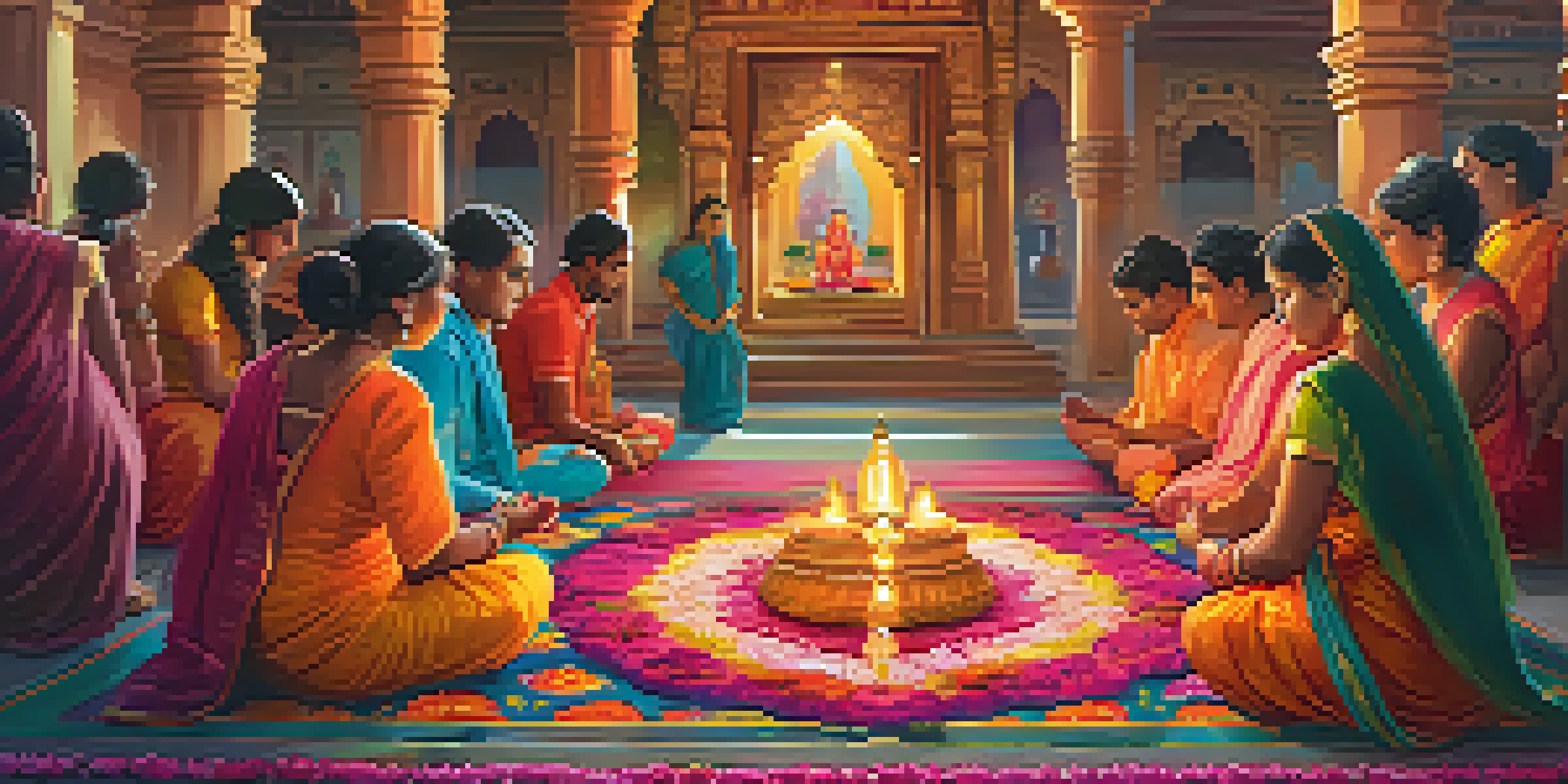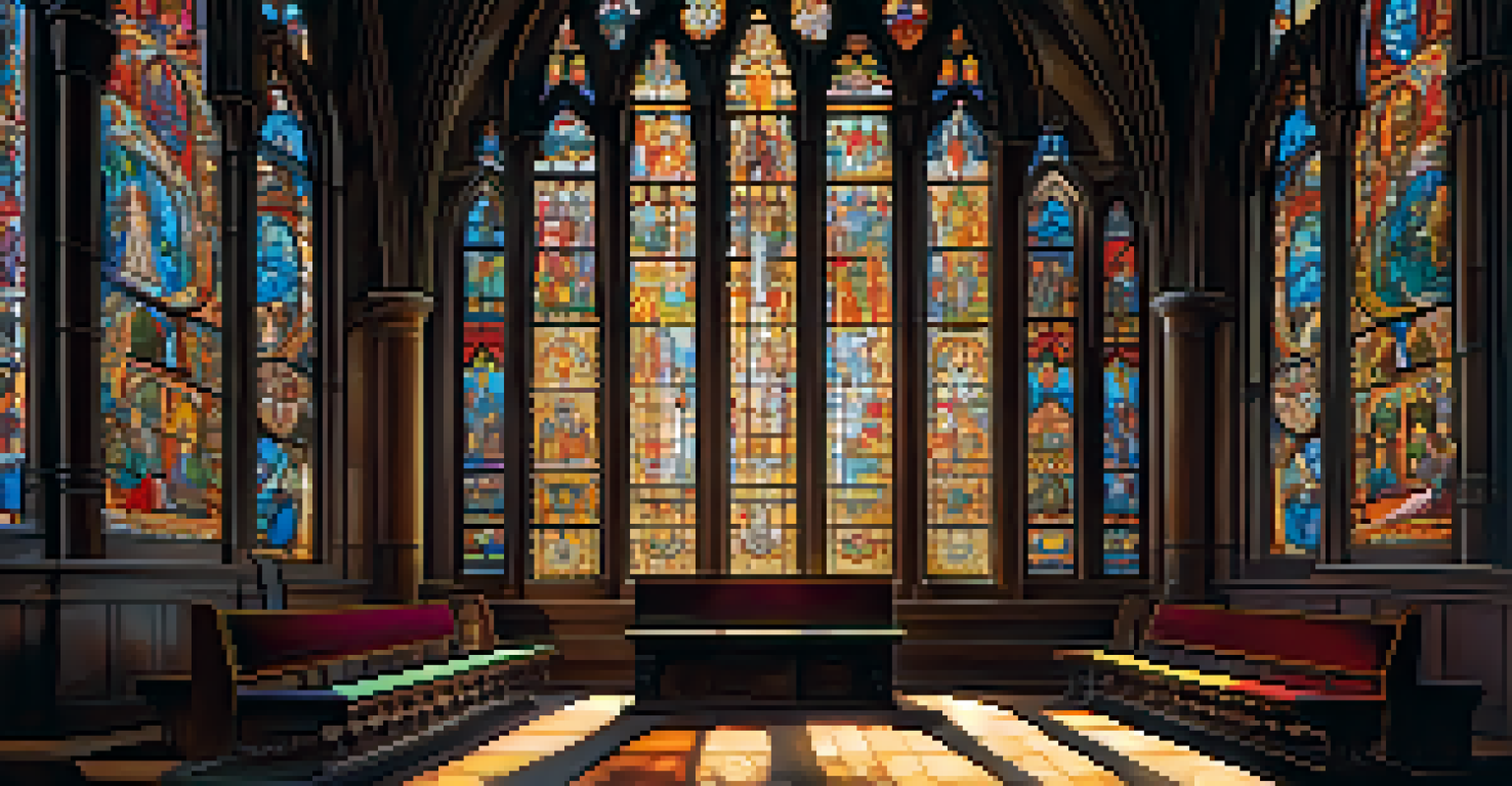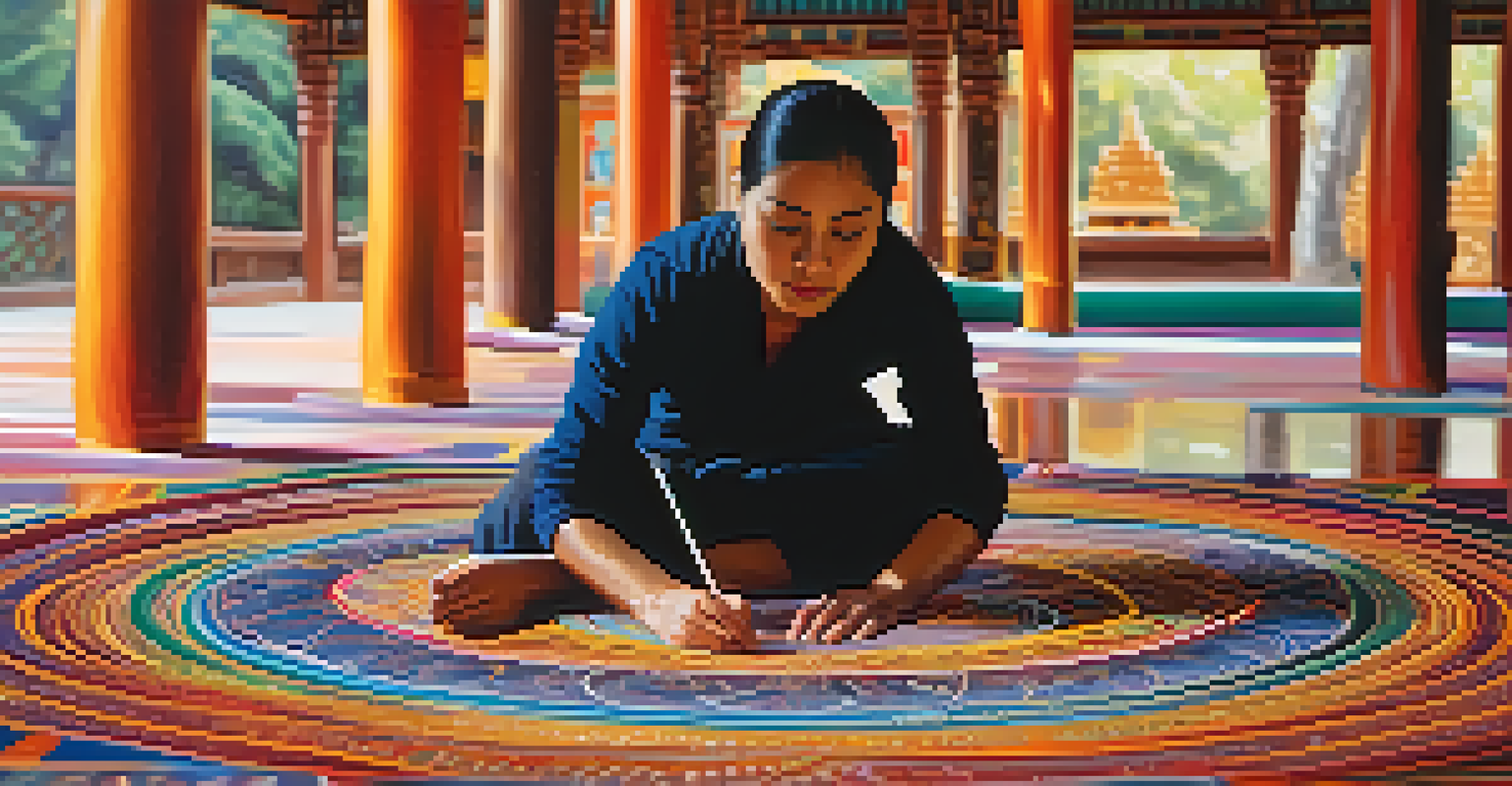The Impact of Rituals on Artistic Expression in Religious Contexts

Understanding Rituals and Their Significance in Religion
Rituals play a pivotal role in many religious traditions, serving as a structured way to express faith and community. They often involve a set sequence of actions performed during important times, such as ceremonies or festivals. These practices help individuals connect with the divine, reinforce cultural identity, and foster social bonds within religious groups.
Art is the most beautiful of all lies; it is a symbol of truth and faith intertwined.
The significance of rituals goes beyond mere tradition; they invite participants into a shared experience that transcends everyday life. This transformation can evoke deep emotional responses, turning routine moments into profound encounters with spirituality. Hence, rituals are not just actions; they are embodiments of belief and values that shape a community's culture.
For example, in Hinduism, rituals like Puja (worship) involve offerings and prayers that create a sacred atmosphere. This not only honors deities but also inspires artistic expressions like intricate rangoli designs or beautifully crafted idols, showcasing how closely intertwined rituals and art can be.
Art as a Medium for Expressing Religious Rituals
Art serves as a powerful vehicle for expressing the emotional and spiritual dimensions of religious rituals. Whether through paintings, sculptures, or music, artists capture the essence of these practices and convey their significance to a broader audience. This connection between art and ritual allows for a deeper understanding of faith experiences.

Consider the use of stained glass in churches, which transforms light into vibrant stories of faith. Each piece not only decorates the space but also enhances the ritual experience by visually narrating biblical tales and inviting reflection. This illustrates how art can elevate the spiritual atmosphere, making rituals more engaging and memorable.
Rituals Foster Community and Faith
Rituals provide structured ways for individuals to express their faith and strengthen social bonds within religious groups.
Moreover, the act of creating art as part of religious rituals can itself be a form of worship. For many artists, the process of crafting a sacred object or performance is an offering, blending creativity with devotion. This dual purpose enriches both the artist's journey and the community's experience, weaving art into the fabric of religious life.
Cultural Variations in Ritualistic Artistic Expression
Artistic expressions of rituals can vary widely across cultures, reflecting unique beliefs, values, and histories. In African traditional religions, for instance, masks and sculptures are integral to rituals, often symbolizing ancestral spirits. These artistic forms not only serve a functional purpose during ceremonies but also embody cultural narratives passed down through generations.
Ritual is the way we make sense of our lives, a bridge that connects us to something greater than ourselves.
Similarly, in Buddhist traditions, mandalas are created as a form of meditative practice and ritual. These intricate designs are often made from colored sand and symbolize the universe, capturing the essence of spiritual journeys. The act of creating and ultimately dismantling a mandala underscores impermanence, a key concept in Buddhism, and showcases how art can express complex philosophical ideas.
These cultural variations highlight the adaptability of rituals and art, demonstrating that while the core spiritual intent may remain, the artistic expression can take on many forms. Each culture adds its own flavor, making the study of rituals and art a rich tapestry of human experience.
The Role of Performance in Ritualistic Art
Performance art is another vital aspect of ritualistic expression, where movement, music, and drama converge to create immersive experiences. Many religious traditions incorporate dance and theater into their rituals, enhancing the emotional and communal elements of worship. These performances are not just entertainment; they serve to convey sacred stories and spiritual truths.
For example, in the Christian tradition, the reenactment of the Passion of Christ during Holy Week brings to life the events leading up to Easter. This dramatic portrayal invites participants to reflect deeply on themes of sacrifice, redemption, and hope. Such performances can foster a sense of shared identity among congregants, reinforcing their collective faith.
Art Enhances Ritual Experiences
Art serves as a powerful medium that amplifies the emotional and spiritual dimensions of rituals, making them more engaging and memorable.
Additionally, the interactive nature of performance allows for deeper engagement. Audiences are not just passive observers; they become part of the ritual, participating in the spiritual journey. This dynamic exchange enriches both the performers and the audience, creating a memorable and transformative experience.
Modern Adaptations of Rituals in Artistic Expression
In today's rapidly changing world, many religious rituals are evolving to incorporate contemporary artistic expressions. Artists are experimenting with new mediums and technologies, transforming age-old rituals into modern experiences. This adaptation not only keeps traditions alive but also makes them relevant to younger generations seeking connection.
For instance, some churches are using digital art and multimedia installations during worship services to engage congregants in innovative ways. These modern approaches can enhance the atmosphere, making rituals feel more accessible and relatable. The fusion of technology and tradition creates exciting opportunities for creativity that resonate with diverse audiences.
Moreover, street art and public installations often carry spiritual messages, reflecting the beliefs and values of communities. Artists use urban spaces to convey their interpretations of spirituality, breaking down barriers and inviting broader conversations about faith. This demonstrates how art continues to evolve, serving as a bridge between tradition and modernity.
The Emotional Impact of Rituals on Artistic Creation
Rituals often evoke strong emotions, which can significantly influence artistic creation. The feelings of joy, sorrow, hope, or reverence experienced during rituals can inspire artists to express their reflections through various art forms. This emotional connection fosters a deeper understanding of both the rituals themselves and the broader spiritual themes they represent.
For example, many artists have drawn inspiration from personal experiences of loss during rituals such as funerals or memorial services. The resulting artworks can serve as cathartic expressions of grief, helping both the artist and the community process their emotions. These pieces often resonate with viewers, creating a shared space for reflection and healing.
Modern Innovations Revive Traditions
Contemporary artistic expressions are evolving rituals, integrating technology and new mediums to keep traditions relevant for younger generations.
Additionally, the communal aspect of rituals can amplify emotional responses, leading to collaborative artistic efforts. When individuals come together in a shared experience, the collective energy and emotions can spark creativity, resulting in unique art that embodies the spirit of the community. This dynamic interaction between emotion and creativity highlights the profound impact of rituals on artistic expression.
The Future of Rituals and Artistic Expression
As society continues to change, the relationship between rituals and artistic expression will likely evolve as well. New forms of expression may emerge, influenced by cultural shifts and technological advancements. This evolution presents both challenges and opportunities for how we understand and engage with rituals in artistic contexts.
It's crucial for communities to find ways to honor traditional practices while encouraging innovation in artistic expressions. Balancing respect for heritage with the desire for contemporary relevance can lead to vibrant and meaningful experiences that resonate across generations. This adaptability will be key in ensuring that rituals remain a vital part of cultural life.

Ultimately, the ongoing dialogue between rituals and art serves as a testament to the human spirit's creativity and resilience. By celebrating this relationship, we can foster deeper connections to our faith, culture, and one another, paving the way for a future where both ritual and artistic expression thrive in harmony.